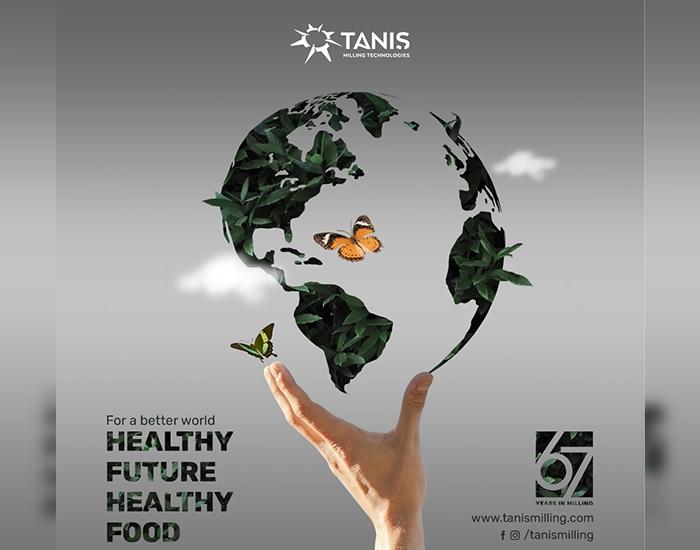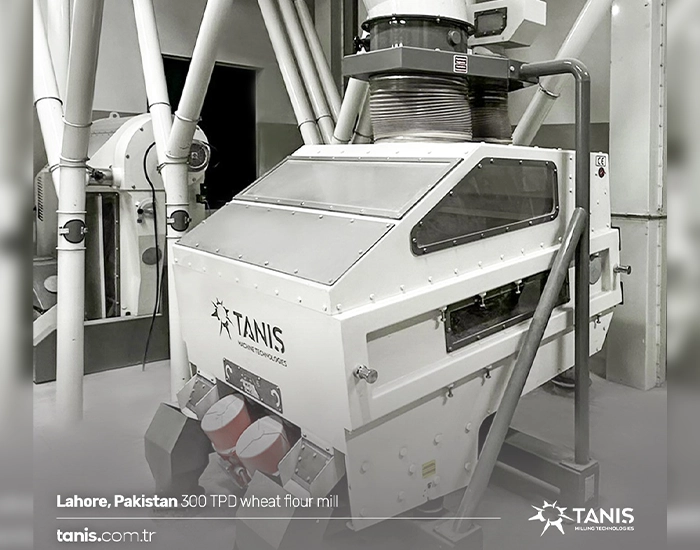The mill sector, as one of the fundamental pillars of global food security, is an industry of strategic importance worldwide. Today, over 800 million tons of wheat are processed, and approximately 450 million tons of flour are produced. The increasing world population, changing consumer preferences, technological advancement, and sustainability requirements continuously shape the sector’s dynamics. In this content, we will comprehensively address global trends in the mill sector, market dynamics, and factors directing the future.
World Grain Production and Consumption Statistics
Global annual wheat production ranges around 780 million tons, with approximately 70% of this production used in flour production. China (17%), India (14%), Russia (10%), USA (7%), and EU countries (20%) are the main wheat producers. In corn production, the USA, China, and Brazil stand out with 1.2 billion tons.
From a consumption perspective, the Asian continent accounts for 45% of world flour consumption, followed by Europe (25%), Africa (15%), America (12%), and Oceania (3%). In per capita flour consumption, Middle East and Central Asian countries rank first with 120-150 kg annually.
Global Economic Value of the Mill Sector
The mill equipment market is at an annual level of $12 billion globally and shows a 5-6% annual growth rate. The flour production value chain, including raw materials, processing, packaging, and distribution channels, reaches an economic volume of $150 billion.
The sector provides direct employment to approximately 6 million people worldwide, while this figure exceeds 30 million when including related sectors (agriculture, logistics, bakery, pasta, etc.). It holds a strategic position in terms of food security and economic development, especially in developing countries.
Developed markets (Europe, North America, Japan) are characterized by high automation levels, consolidated industry structure, and low capacity growth, while developing markets (Asia, Africa, Latin America) show rapid capacity increase, modernization needs, and fragmented market structure.
In terms of technology adaptation, facilities in Western Europe, North America, and Japan are approaching Industry 4.0 levels, while different technology generations coexist in developing regions. However, technology adaptation is accelerating especially in newly established facilities, with approaches to global standards being observed.
Key Global Trends in the Mill Sector
Consolidation and Scale Growth
A clear consolidation trend is occurring in the mill sector. With over 200 merger and acquisition transactions in the past five years, market concentration is increasing especially in developed markets. In the USA, the top 10 mill groups control 85% of the market, while in Europe they control 65%.
With the rise of corporate groups, average mill capacity is also increasing. The pursuit of economies of scale accelerates the orientation toward large-scale facilities that provide 15-25% advantages in energy and operational efficiency. Small and medium-scale enterprises try to compete by focusing on niche markets or with specialized products.
The tendency to control the entire value chain from raw materials to final products is strengthening. Backward integration ensures wheat supply security, while forward integration increases orientation toward value-added final products. Mill groups, especially in North America and Europe, also operate in flour products, pasta, and other grain-based food production.
Contract production models are becoming widespread, especially for special products (organic, gluten-free, high-protein, etc.). Direct agreements with farmers secure the supply of wheat with specific quality characteristics, ensuring consistency in final product quality.
Sustainability and Environmental Responsibility
Sustainability has become one of the strongest trends in the sector. Low carbon footprint, water conservation, waste management, and energy efficiency have become priority issues in facility design and operation. Leading companies set targets to reduce carbon emissions by 50% by 2030.
Certification and sustainability reporting are now becoming a necessity rather than a choice. Besides standards like ISO 14001, LEED, BREEAM, special sustainability assessment systems are also becoming widespread. Investors and consumers increasingly question companies’ environmental performance.
The mill industry has begun to evaluate the opportunities offered by digital transformation. Smart factories with high automation levels and AI-supported decision mechanisms are becoming widespread. More than 80% of new facilities established especially in developed markets are equipped with full automation systems.
IoT sensors and real-time monitoring systems provide process optimization and predictive maintenance opportunities. These technologies reduce energy consumption by up to 20%, lower operating costs, and ensure product quality consistency. Data analytics and artificial intelligence applications are becoming widespread to achieve stable flour quality despite raw material variability.
Nutritional Preferences and Health Consciousness
Changes in consumer preferences are also transforming the product portfolio in the sector. Demand for whole grain and bran products has increased by 45% in the past five years. Functional flours (protein-enriched, vitamin-fortified, fiber-enhanced) have become a rapidly growing segment.
Gluten-free and low-carbohydrate alternatives constitute a niche but rapidly growing market. The gluten-free grain products market shows 8-10% annual growth, while alternative flours like almond flour and coconut flour record 15-20% growth. This situation directs mill operations toward product diversification and investment in new processing technologies.
Clean Label and Transparency Expectations
Modern consumers demand more information about food product contents and production processes. Clean label (minimum additives, natural ingredients) is no longer a luxury but has become a basic expectation. This trend encourages flour producers to create more transparent supply chains and increase product traceability.
Demand for organic and non-GMO products shows 12-15% annual growth in developed markets. Organic flour production has raised its market share to 5% in Europe and 7% in the USA. This situation requires mill operations to establish separate production lines or completely convert their facilities to organic production.
Raw Material Security and Supply Diversification
With the impact of climate change and geopolitical tensions, raw material security has become a strategic issue. Climate-induced fluctuations in global wheat production are increasing, while political crises and trade wars can disrupt supply flows. This situation directs mill operations toward diversifying supply sources and developing risk management strategies.
Variability in grain quality brings standardization challenges. Fluctuations in protein ratio, gluten quality, and other critical parameters require mills to use more flexible process management and advanced blend optimization systems. R&D studies are accelerating for the development and popularization of climate-resistant wheat varieties.
Localization and Regional Production Movements
Increased logistics costs and supply chain fragilities strengthen the local production trend. The “nearshoring” strategy is becoming widespread, especially with multinational mill groups establishing new facilities in regions close to their main markets.
Trade wars and protectionist policies affect international grain and flour trade. This situation directs companies to develop stronger relationships with local suppliers and create on-site production capacity. New mill investments are particularly increasing in Africa and Southeast Asia.
Energy Efficiency and Resource Optimization
Rising energy costs and sustainability goals accelerate investment in energy-efficient systems. New generation mill equipment provides 30-40% less energy consumption, while heat recovery systems improve facilities’ energy balance.
Reducing water consumption is also among priority issues. With closed-loop water systems, advanced treatment technologies, and dry cleaning processes, water usage can be reduced by up to 50%. In waste management, evaluation of by-products (bran, germ, etc.) contributes to economic and environmental sustainability.
Quality Control and Food Safety Developments
Advanced analytical and test methodologies are creating new standards in quality control. NIR (Near Infrared) spectroscopy provides rapid protein and moisture analysis, while inline sensors enable real-time process control. Advanced screening systems for mycotoxin management and contamination control are becoming widespread.
Digital imaging and spectral analysis technologies enable non-destructive quality control. These systems are used in all processes from raw material acceptance to final product evaluation, enabling instant detection of quality deviations and taking corrective actions.

Regulatory Environment and Standards
Food Safety Regulations and Compliance
Food safety regulations are tightening on a global scale. International standards such as FSMA (US Food Safety Modernization Act) and GFSI (Global Food Safety Initiative) force mill operations to establish comprehensive food safety systems.
Traceability requirements necessitate uninterrupted tracking systems from raw materials to final products. Blockchain and other digital traceability solutions have begun to be used to increase supply chain transparency. Proactive approaches are replacing reactive controls, and hazard analysis and risk assessment systems are becoming widespread.
Tanış A.Ş.’s Global Approach and Vision
Bringing Global Trends Together with Local Solutions
As Tanış A.Ş., we closely follow global trends and transform these trends into solutions adapted to local customer needs. In our innovation centers, we analyze best practices in developed markets and develop applicable technology solutions for our customers in different geographies.
Our global knowledge accumulation and local application experience help mill operations gain regional competitive advantage. Our R&D activities focus on energy efficiency, sustainability, digitalization, and product quality optimization.
Our International Market Presence
Operating in over 40 countries, Tanış A.Ş. has a strong global presence. Our strategic centers in Europe, Middle East, Africa, and Asia regions provide local support and fast service to our customers. Our over 500 international reference projects are indicators of our global experience and reliability.
Our export-oriented strategy aims to offer customized solutions that consider the unique dynamics of each market. While evaluating growth potential in developing markets, we continue to strengthen our technology leadership in developed markets.

Frequently Asked Questions
Digitalization and Industry 4.0 adaptation, sustainability-focused production, market consolidation, value chain integration, and changes in consumer preferences will be the main trends shaping the sector. Particularly, the use of artificial intelligence and data analytics, energy efficiency technologies, and special-purpose flour production will stand out.
Sustainability strategy can be implemented through energy-efficient equipment investments, renewable energy use, water conservation systems, waste reduction, and by-product evaluation programs. These investments provide financial advantage by reducing operational costs while offering access to premium markets through sustainability-focused branding.
Conclusion and Call to Action
Understanding global trends in the mill sector and adapting to these trends is critically important for sustainable competitive advantage. As Tanış A.Ş., with our global vision and local expertise, we support mills in preparing for the future.
